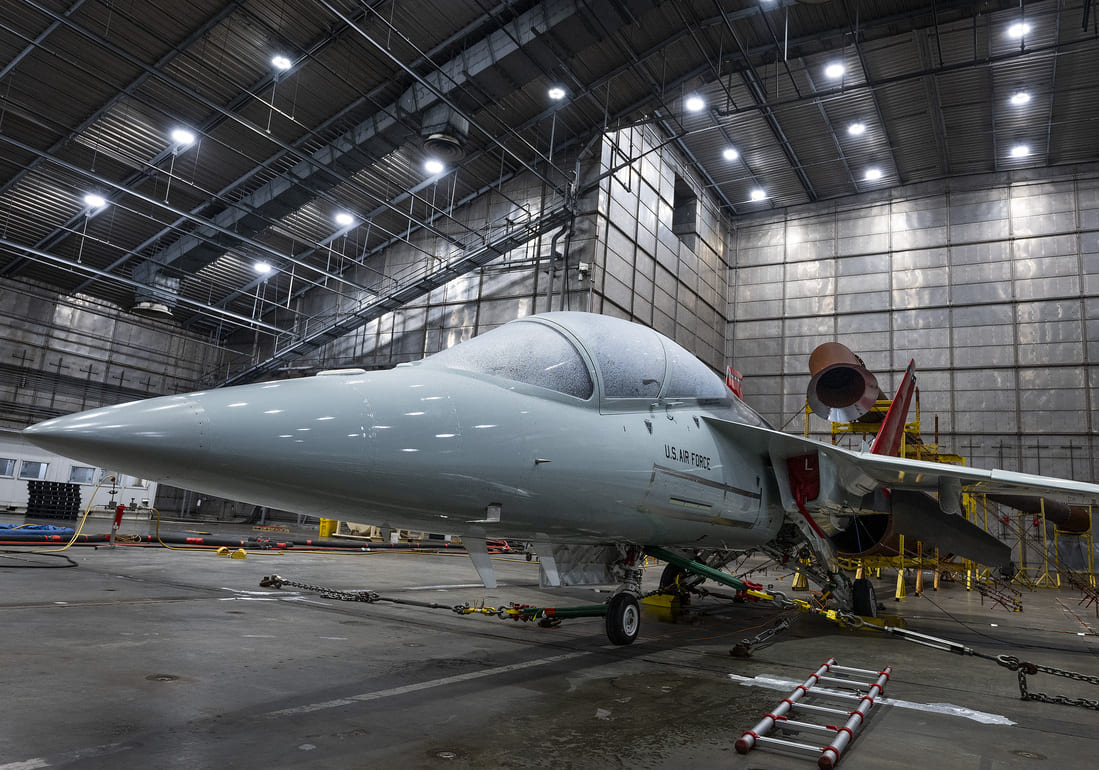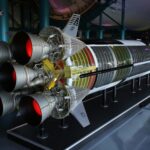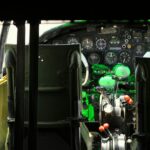NATIONAL HARBOR, Md. Air Education and Training Command leaders detailed the fielding steps for the T-7A Red Hawk. The first non-test jet arrives at Joint Base San Antonio-Randolph on Dec. 5, 2025, to start instructor familiarization and maintenance workups before any student sorties. “All of the aircraft that the T-38 was designed to train for retired 30-plus years ago,” Maj. Gen. Clark Quinn said.
The opening aircraft will fly routine events to generate real wear so maintainers can practice fault isolation, inspections, and part swaps under Boeing supervision, then transfer routine work to Air Force crews. Defense officials confirm a second jet in spring 2026 at Randolph and a local fleet building to 14 aircraft. Initial operational capability at Randolph is targeted for August 2027.
Quinn tied the arrival to a staged instructor plan. Early months center on procedures, emergency handling, and running multi-display training events from the T-7A cockpit. Student events open after the cadre is current and standardized. Production aircraft then shift straight from the factory to the first student base – Columbus Air Force Base in Mississippi – where new pilots begin on the T-7A in early 2028.
The service still intends to replace the Talon across training wings, but pace follows production. Program figures keep the total buy in the mid-300s, with planning references citing 351 aircraft to replace T-38C squadrons. At steady state AETC expects 48 to 60 deliveries per year, enough to swap a squadron roughly each year. According to industry sources, that rate depends on parts flow and vendor stability across avionics, ejection seats, and mission-system components.
T-7A arrival at JBSA Randolph and instructor conversion
Dec. 5 at Randolph starts instructor flights, not student training. The first jet will run functional checks, syllabus development sorties, and structured maintenance training. Boeing teams handle most early maintenance while teaching Air Force crews to take over, a common handoff during type introduction. Officials confirm the goal for 14 aircraft at Randolph for IOC in August 2027, with the second aircraft arriving in spring 2026 to widen training and maintenance exposure.
Quinn explained the instructor-first sequence. T-7A handling and systems management differ sharply from the Talon, so instructors need time in the seat and in new ground devices to build the “demo and talk” flow used with students. The plan leans on integrated simulators so the first months will validate device fidelity against the jet and lock down event scripts.
Test aircraft at Edwards continue envelope work, and a jet that cycled through climatic trials at Eglin informs procedures. Those trials cleared cold-soak and heat profiles, winds, icing, and systems behavior in extremes. Results feed instructor techniques and maintenance checklists at Randolph.
AETC syllabus changes and end-of-formation takeoffs
AETC removed formation takeoffs and landings from the undergraduate syllabus. Operational units no longer use those mass-launch tactics, and time shifts to tasks relevant to modern fighters and bombers. Quinn said the Talon’s landing behavior once consumed outsized instructor effort near the runway, a habit pattern that doesn’t carry into fifth-generation aircraft. Maj. Gen. Gregory Kreuder added newer fighters are easier to fly yet harder to employ well, so training hours move toward sensors, decision making, and tactical employment.
The T-7A’s multi-display cockpit matches front-line fighters. Instructors can introduce data-link management, weaponeering logic, and sensor use earlier in a career. Kreuder called the airplane gentle and predictable, closer in handling to an F-16 or F-35 than a Talon, and well matched to ground devices where crews rehearse radar workloads, electronic protection, and threat reactions. The aim isn’t to push advanced tactics into undergraduate training, but to stop teaching dead-end habits tied to legacy airframes.
The pipeline will tie more events to the ground-based environment than the Talon allowed. Embedded training and live-virtual-constructive links sit in the curriculum, reducing air hours on tasks that simulators teach well. Instructors still need airborne time for formation basics and airmanship, but the balance tilts toward systems use and mission management.
Ejection seat and climate tests in 2025 and safety updates
The escape system drew heavy scrutiny after earlier reports flagged hazards around small-stature aircrew and sequencing. A series of 2025 sled events validated a redesigned canopy fragmentation and a new seat sequencer, steps the program required for airworthiness. Separate climate-lab trials at Eglin in June pushed the aircraft through temperature and wind extremes, while flight testing at Edwards kept expanding the envelope and mission-system checks.
Senior training leadership also flew the jet. AETC’s commander flew the T-7A in late April, an early confidence marker and a direct comparison of handling and workload with current fighters. Those events, combined with the escape system and climate results, informed acceptance planning for Randolph. Defense officials confirm the Dec. 5 delivery date remains the working mark, aligned to these safety and verification steps.
Earlier hurdles – wing rock at high angle of attack, software tuning for flight controls, and parts quality escapes – remain on the record and explain why the service re-sequenced buys and stretched schedules. Those items drove the January decision to add production-representative test aircraft and delay a production contract action, increasing the test fleet to gather more data before opening the student pipeline.
Production rate targets and 351 aircraft procurement plan
Acquisition adjustments published in January set a framework to meet AETC training needs while finishing essential fixes. The Air Force expanded the test fleet with additional production-representative jets and moved its low-rate production decision to align with verification work. That sequence protects the Randolph instructor phase and supports the early-2028 start at Columbus without overcommitting fleets before the escape system and software items mature.
Fleet replacement still centers on a requirement in the mid-300s, historically cited as 351 aircraft, with deliveries paced to replace T-38C units base by base. Planning calls for steady deliveries in the upper double digits per year once production reaches full pace. Our analysis shows that gating factors now sit in three places: escape-system qualification for all pilot body sizes, software stability for training loads, and supplier throughput on avionics and structures, because those determine whether Randolph holds in August 2027 and whether Columbus opens in early 2028.
The age and availability of the T-38C argue against long extensions. Reported availability fell to the mid-50s in recent tracking, which raises maintenance hours per flight and narrows surge margin at training wings. A slower T-7A ramp would keep more Talons on the line, raising cost and schedule risk.
Instructor and maintainer training at Randolph helps offset that risk. As teams shift from Boeing-led maintenance to organic crews, they will certify processes and troubleshooting steps other wings adopt later. Columbus then receives aircraft supported by a stable instructor corps and a tested maintenance playbook. Added ground devices and higher-fidelity simulators let squadrons move some events off the flight line, helping the pipeline absorb students without waiting for every last airframe.
Quinn’s remarks at National Harbor outlined where instructors will spend time. Less effort rescuing students from the Talon’s quirks, more on mission employment they will see again in operational conversion. Kreuder echoed the point with a comparison to modern fighters and how automation frees pilots to work the mission, not the airframe.
Columbus AFB will be the first student location for Red Hawk. The base receives aircraft directly from the production line once deliveries start to surge. Production planning envisions two to three aircraft per month early, with most heading straight to student use. The big numbers in 2028 and 2029 accelerate retirement of Talon squadrons and reduce the double-maintenance burden on training wings.
The teaching approach follows the structure built at Randolph. Students will see cockpit displays that match conversion units, so they learn to manage information, datalinks, and weapons in a scaffolded way before they ever touch an F-35 or B-21 trainer. Embedded training carries a chunk of that load, while airborne sessions keep fundamentals sharp and build confidence when the airplane stops being predictable.
Red Hawk’s arrival doesn’t erase every risk. Parts must arrive on time and in the right order, and ground devices need to track software loads so instructors teach what the jet actually flies. The escape system stays under watch until all test points with the updated sequencer and canopy work are complete.
Asked why the service keeps pushing to the T-7A even with setbacks, Quinn pointed to the core issue. The Talon trained pilots for jets that left the force decades ago. The Red Hawk’s cockpit, avionics, and embedded training meet current needs, and the basing plan at Randolph and Columbus provides the path to put it into action.
REFERENCE SOURCES
- https://www.defensenews.com/air/2025/10/01/us-air-force-revamps-pilot-training-as-t-7-era-nears/
- https://www.airforcetimes.com/air/2025/10/01/us-air-force-revamps-pilot-training-as-t-7-era-nears/
- https://www.airandspaceforces.com/usaf-rejiggers-t-7-plan/
- https://www.aetc.af.mil/News/Article-Display/Article/4029934/air-force-updates-t-7a-acquisition-approach-to-field-operational-capability/
- https://www.eglin.af.mil/News/Article-Display/Article/4195580/t-7a-red-hawk-flight-confirms-safety-progress/
- https://www.jbsa.mil/News/News/Article/4231618/t-7a-red-hawk-endures-ice-winds-sun-in-new-phase-of-climate-tests/
- https://www.airandspaceforces.com/t-7-new-ejection-seat-november-2027-ioc/
- https://www.aerospacetestinginternational.com/news/t-7a-red-hawk-completes-successful-escape-system-sled-test.html
- https://theaviationist.com/2025/05/05/t-7a-ejection-system-test/
- https://www.defensenews.com/air/2025/03/06/air-force-aircraft-readiness-plunges-to-new-low-alarming-chief/



